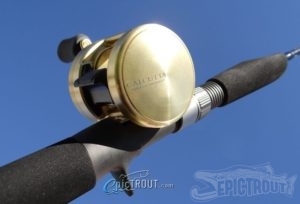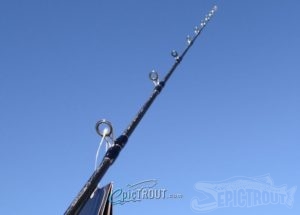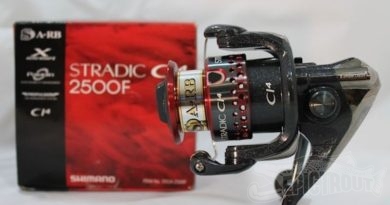jigging rod and reel

By Brad Stout
I wanted to find a rod and reel combo for speed jigging and vertical jigging for jigs weighing up to 6 ounces. Rods need to be flexible at the tip but still have plenty of backbone for setting the hook. Also, I was looking for a long rear grip section so when jigging the rear section would extend to my elbow for better leverage. I found exactly what I was looking for in the Shimano TVC70L Trevala Jigging Rod.

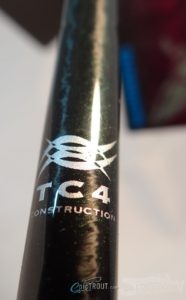
The TVC70L is a 7’0″ light to medium action rod that retails for $ 199.00. Shimano uses the TC4 Construction Material and 9 Fuji Hardloy guides that keep the rod bent perfectly while fighting a fish. I really liked custom shaped EVA foregrip and reargrip for comfort and balance while jigging. The foregrip has a flat spot on the top which is the perfect place to rest your thumb while speed jigging. When jigging in the traditional vertical style the rod’s 14″ rear grip allows me to slide the rod forward to palming the reel. TVC70l also comes with a lifetime warranty. The powerful, lightweight, and light action Shimano Trevala Jigging Rods are to be used with high speed, high power reels such as a Shimano Trinidad Narrow but I wanted a smaller round reel with an easy to deploy thumb bar to release the line . Knowing that I wouldn’t be fishing much deeper than 200 feet, the smaller the real the better so I chose the Calcutta CT201B.
The Calcutta CT201B is a small, medium weight, left-handed reel in the classic round shape that retails for $219.00. It has a line capacity of 210 yards of 10 pound test and a super fast gear ratio of 6.0:1 that pulls in 27″ per crank of the handle. Built with a cold forged aluminum frame, side plates, spool, and anti-rust bearings that are approved for saltwater. For most trout anglers, saltwater is not important, but since I live in Nevada and so close to Pyramid Lake, it’s a top consideration for me. Pyramid Lake is so salty or alkaline that it’s recommended that boat anglers flush their motors after every use.
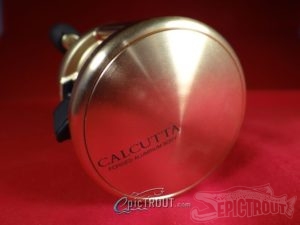
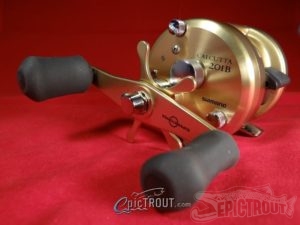
I put the combo to the test and found that the rod and reel were made for one another when it comes to deep freshwater trout fishing. When vertical jigging in depths over 75 feet, I like to have more weight in my jig. It’s not uncommon for me to use a 4 ounce jig in 100 to 200 feet of water when pursuing trophy size lake trout. On windy days I may have to increase the weight of my jig to 6 ounces to stay in the strike zone. The idea is to have the jig slowly rise and flutter down in one steady motion allowing the fish to acquire and strike the jig. The tip of the rod has just the right amount of light action to keep the jig from fouling as it bounces up and down. This rod has plenty of backbone as I set the hook.
The rod was initially designed by Shimano as a speed jigging rod. When speed jigging, the angler tries to hold the reel in a fixed position and rotate the rod in a circular motion around the reel so you are actually cranking in the line with the rod and not necessarily with the reel handle. The circular motions feel more natural by placing your thumb on the flat spot on the front foregrip. In my opinion, this style of rod is really the only way to efficiently speed jig for periods longer than just a few minutes.
This is my 9th Calcutta that I have owned over the years in various different sizes. For this application the 201 is a perfect marriage for the TVC70L. From the first time I pick up the 201 I knew I had a quality reel in my hand and couldn’t wait to fight a fish on it. When retrieving the line, the first things I noticed is how smooth and quiet the reel is. When deploying the line for jigging, I simply unscrewed one screw and effortlessly removed the side plate exposing the Variable Brake System (VBS) . I quickly turned off all six brakes and reassembled the reel. When vertical jigging, I prefer that the brakes are turned off. Instead, I allow my thumb to become the brake by gently applying pressure to the spool . This allows me to pause the jig and then return to letting line out without engaging the reel.
This rod and reel system is definitely an overkill for fighting smaller trout and even some of our trophy size trout. The real magic of the system is its ability to have complete control over your jig at all times and to detect the slightest hit from a finicky trout. With all the new and different fishing techniques now available to trout fishermen, its not hard to imagine why fisherman they have so many rods . What we have learned from the bass anglers is, different technique requires different equipment . Now days the fishing manufactures are building technique specific rods and reels to help maximize lure control and keep them in the strike zone. For this angler,I could never have to many rods and reels
